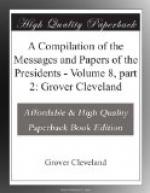Under the agreement made between the United States and the Muscogee (or Creek) Nation of Indians on the 19th day of January, 1889, an absolute title was secured by the United States to about 3,500,000 acres of land. Section 12 of the general Indian appropriation act approved March 2, 1889, made provision for the purchase by the United States from the Seminole tribe of a certain portion of their lands. The delegates of the Seminole Nation, having first duly evidenced to me their power to act in that behalf, delivered a proper release or conveyance to the United States of all the lands mentioned in the act, which was accepted by me and certified to be in compliance with the statute.
By the terms of both the acts referred to all the lands so purchased were declared to be a part of the public domain and open to settlement under the homestead law. But of the lands embraced in these purchases, being in the aggregate about 5,500,000 acres, 3,500,000 acres had already, under the terms of the treaty of 1866, been acquired by the United States for the purpose of settling other Indian tribes thereon and had been appropriated to that purpose. The land remaining and available for settlement consisted of 1,887,796 acres, surrounded on all sides by lands in the occupancy of Indian tribes. Congress had provided no civil government for the people who were to be invited by my proclamation to settle upon these lands, except as the new court which had been established at Muscogee or the United States courts in some of the adjoining States had power to enforce the general laws of the United States.
In this condition of things I was quite reluctant to open the lands to settlement; but in view of the fact that several thousand persons, many of them with their families, had gathered upon the borders of the Indian Territory with a view to securing homesteads on the ceded lands, and that delay would involve them in much loss and suffering, I did on the 23d day of March last issue a proclamation[3] declaring that the lands therein described would be open to settlement under the provisions of the law on the 22d day of April following at 12 o’clock noon. Two land districts had been established and the offices were opened for the transaction of business when the appointed time arrived.




